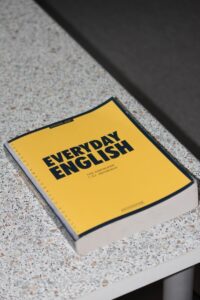Language learning can be a challenging yet rewarding journey, and mastering the most commonly used English words is an essential part of it.
The most commonly used English words that made it to the top 10 are words that are parts of speech. These words are used by native and non-native speakers alike. It is the basis of all the essential words in the English dictionary. Knowing the fundamentals of this language is vital to step into broadening our language knowledge. In this article, we also included the common ways in which a non-native speaker of English can speak English fluently.
So, what are the ten most commonly used English words? Let’s take a look at this list:
1. The
Pronunciation: It is commonly pronounced as /t͟hə/ and usually /t͟hē/. The first pronunciation is generally used before consonants and sometimes before vowels. The latter usually appears before vowels to emphasize and give distinction to titles and names.
Etymology: It came from Middle English, and its first known use is its function as a definite article before the 12th century.
Common Usage: ‘The’ is an article word. It’s a function word that shows that the next noun word or noun equal to it is definite or previously mentioned.
Example: Turn off the lights.
It also appears before a noun word to indicate natural phenomena
Example: The summer solstice.
“The” also labels the next noun or noun with the same equal state is a rare or a very particular being of its class.
Example: the King
This function word appears before a proper like as in a renowned landmark as well.
Example: the Statue of Liberty
2. Of
Pronunciation: /əv/
Etymology: The word ‘of’ was first known and used before the 12th century. It was used as a preposition and as an auxiliary verb.
Common Usage: It expresses separation from something.
Example: relieved of burdens
‘Of’ is also used before an epithet to indicate birthplace, residence, or any place closely related to the individual.
Example: Jesus of Nazareth, Saint Anthony of Padua
The word ‘of’ also indicates cause or reason.
Example: obligated of liabilities
It also acts as a function word corresponding direction to the point of estimation
Example: to the south of the city
‘Of” also indicates the origin or source of something.
Example: the blood of great lineage
Lastly, it relays the same meaning as the word ‘about.’
Example: fondness of babies
3. To
Pronunciation: /to͞o/ and sometimes /tə/.
Etymology: The word ‘to’ is both a preposition and an adverb. Early records show that English speakers used this word long before the 12th century.
Common Usage:
‘To’ is a function word that describes movement or action. It also pertains to a motion suggesting a movement toward someplace, a person, or a thing.
Example: went to the office, drove to the farm
You can also use this function word to signal direction or command.
Example: moved closer to me
‘To’ also indicates application or attention.
Example: shall dance to, I would love to
4. And
Pronunciation: /ænd/ or /(ə)n/
Etymology: It is an Old English of ‘and,’ ‘on’ with a Germanic origin. It is related to Dutch’s ‘en’ and the German’s ‘und.’ English and German. Notably, it originates from the same family of languages.
Common Usage:
‘And’ connects words existing in the same part of speech, clauses, or sentences are supposedly taken together.
Example: ham and cheese
It also connects clauses, where the second clause is the result of the first.
Example: He stood and turned away.
It also denotes an introduction before saying a new statement unrelated to the first context.
Example: and now to start anew
5. A
The word ‘a’ is an indefinite article. When capitalized, it is the first letter of the alphabet.
Pronunciation: /ā /eɪ / and as /ə/
Etymology: As an indefinite article, the word ‘a’ was first known and used before the 12th century. It originated in Middle English, from the Old English of ‘ā’ which means one.
Common Usage:
‘A’ refers to someone or something for the first time in a dialogue or script.
Example: a thief lurking in the dark, a stranger grabbed my hand
It also appears before units of measure to indicate only one unit.
Example: a million
It also signifies membership in a class of people or things.
Example: He is a politician.
6. In
Pronunciation: /in/
Etymology: As a preposition and an adverb, it was first known and used before the 12th century. In 1599, it was used as an adjective.
Common Usage:
As a preposition, it is used as a function word to signify location.
Example: in the car
As an adverb, it means to move toward the inside of an enclosed area.
Example: Get in the room.
‘In also specifies a relation.
Example: in bad blood with a friend
You cam also use ‘in’ as an adjective.
Example: the in game
7. Is
Pronunciation: /is/
Etymology: It came from Middle English and Old English; it is similar to the Old High German word ‘ist,’ the Latin word ‘est’ and ‘esti’ of Greek.
Common Usage:
-present tense third-person singular of BE
-dialectal present tense first-person and third-person singular of BE
-dialectal present tense plural of BE
8. It
Pronunciation: /it/
Etymology:
As a pronoun, the word ‘it’ was first known and used before the 12th century. As a noun, it was first used in 1842.
Common Usage:
‘It’ denotes the thing formerly mentioned.
Example: A flower with bees that dances to it.
It also refers to the neuter gender; an animal, child, or someone with unspecified sex or gender.
Example: I wonder who it is.
You can also use this pronoun to refer to an abstract object.
Example: The law is above man as it shall be.
As a noun, it pertains to a person engaged in a game, especially hide-and-seek, to indicate the player to perform the game’s action.
Example: He is it, so he goes after us.
9. You
Pronunciation: /yo͞o/ /ju/
Etymology: The first known use of the word ‘you’ was way back in the 12th century.
Common Usage:
‘You’ is used to address a person.
Example: Can you hear me?
10. That
Pronunciation: /T͟Hat/ /ðæt
Etymology: The first known use of the word ‘that’ was in the 12th century. As an adverb, the first known use was in the 13th century.
Common Usage:
‘That’ classifies any specific being or thing that is being observed by the speaker.
Example: That is a magnificent painting.
This word also indicates the time, action, or event that is being talked about.
Example: And that ends the story.
You can also use it to describe an extent.
Example: about that short
And that sums up the list of the top 10 most commonly used English words!
Most Commonly Used English Words and Tips on How You Can Be Able to Speak English Fluently

Take notes!
Jot down unfamiliar words that you come across in your daily life. Whether it’s a new word used by a friend or colleague, or a term you encounter while reading a book or article, take note of it and look up its meaning. By doing this, you can create your own personal dictionary of the most commonly used English words.
This is a more effective way to expand your vocabulary compared to relying on daily “word of the day” notifications on your phone. Additionally, watching movies or shows with English subtitles on Netflix is a great way to encounter new words in context and improve your English fluency.
Read as many books as you can.
Reading books is an excellent way to improve your English fluency, and it can also help you discover the most commonly used English words. To make the most of your reading time, be sure to choose books that genuinely interest you, perhaps by focusing on a particular genre or author. As you read, keep a notebook handy to jot down any unfamiliar words you come across, and make it a habit to look up their meanings.
Converse in English.
In a survey conducted in America, the number one fear Americans fear the most is public speaking. It accounts for about 25.3% in the year 2013. But you don’t have to be afraid of speaking out to the public. Begin with a friend who you can talk to in English completely. And if you can’t start with straight English words, you can do 50-50. As the day goes by, raise the percentage mark by using English more. In due time, you will get used to it. Soon enough, you can converse in English in full 100%.
Do not be afraid to make mistakes.
You are just starting. It is okay to stammer at some point; you’ll loosen it up in a bit. You won’t be an expert and a fluent English speaker in a day. It just don’t happen. It will take time, and you should take your time, too. As much as possible, invest in books or teaching-lessons as well. There is no shortage of free learning materials out there.
Know the basics.
We talked about the most commonly used English words to help give knowledge to English learners, particularly to beginners like you. Once you know the basic English words, you have the foundation to go out there and learn more.




